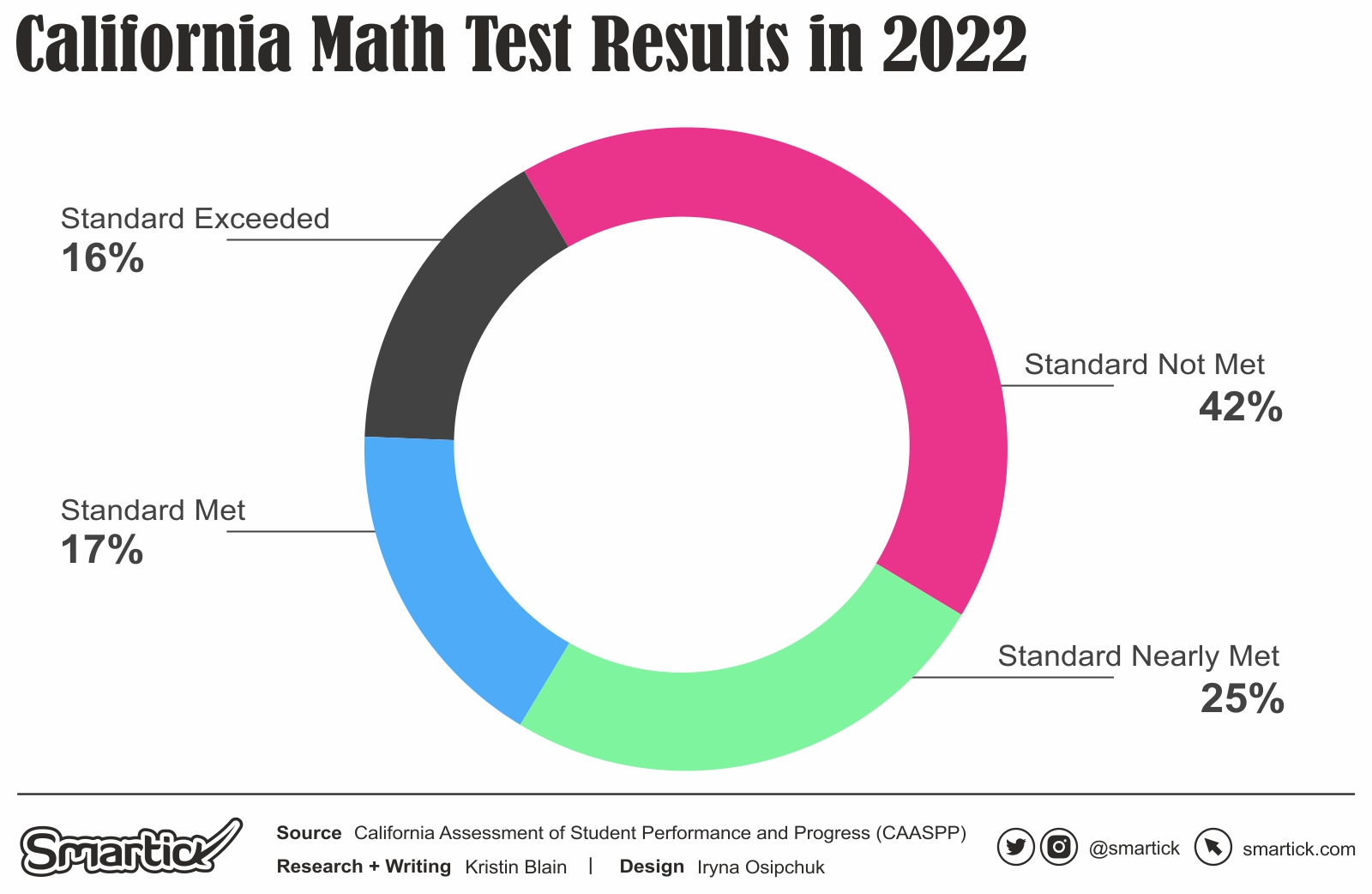
According to the latest reports from the California Assessment of Student Performance and Progress (CAASPP), grade school students across the state continue to fall behind in math achievement, signaling a need for continued efforts in education reform and recovery.

The Smarter Balanced Assessment (SBA) Consortia was developed in response to the call for new state tests in 2010 spurred by Race to the Top— a competitive grant rewarding innovation and reforms in K-12 education across the U.S.
Currently, the Smarter Balanced Summative math assessment is administered annually to students in grades three to eight and used to evaluate achievement and growth toward college and career readiness benchmarks in twenty U.S. states including California.
These computer-adaptive tests are built on a detailed rationale that evaluates student ability in concepts and procedures, problem solving, communicating reasoning, and modeling and analyzing data. The annual math test measures student ability in the following:
- How well do students use the mathematical rules and ideas?
- How well can students show and apply their problem solving skills?
- How well can students think logically and express their thoughts in order to solve a problem?
Student scores fall on a continuous scale from approximately 2000 to 3000 points. Scaled scores can be used to illustrate individual achievement and growth. When combined across a student demographic, scaled scores can also reveal gaps in achievement among different populations. Such score reports can inform future decisions about educational reform that targets populations with the highest needs.
Why California?
Home to over 39 million people, California is the nation’s most populous state. According to data from the U.S. Census Bureau, the Golden State topped the lists in socioeconomic diversity, household diversity, and cultural and linguistic diversity. In other words, California is the ideal state for checking the pulse of the nation’s overall academic achievement in K-12 schools.
Students Post-Pandemic Fall Further Behind
In 2022, the CAASPP released some distressing math data: a mere 33% of its students met or exceeded the SBA standard for math while 67% did not. Compared to results from 2019, where 40% of students achieved the standard and 60% did not, this latest assessment might speak directly to the continued negative impact of the pandemic on the public education system.
Eighth Graders Take Last Place in the Race
In 2022, third graders showed the highest proficiency in math with 44% meeting or exceeding the standard. Eighth graders, however, took last place with only 29% meeting or exceeding the benchmark. This 15% achievement gap that craters elementary and middle school years is nothing new: the size of the gap between grades 3 and 8 averages 11% since 2014.
Math proficiency in eighth grade is one of the most significant predictors of a student’s academic success in high school and in college. Unfortunately, for a large percentage of eighth graders, this predictor does not bode well.
By eighth grade, many students have already formed preconceived notions about their math ability. Many struggle with low self-esteem and high test-taking anxiety. Others may not have the correct academic support, or their teachers might even lack the confidence in their own conceptual understanding, leading to poor math instruction. Additionally, as middle school begins, math concepts grow more abstract— from multi-step problem-solving and proportional relationships to algebraic expressions, graphing, and statistics—exacerbating the potential for high anxieties and low self-esteem.

Ethnic and Racial Disparity Deepens
Since it began reporting SBA math scores in 2015, the CAASPP has exemplified a clear-cut disparity between ethnic and racial groups. These inequalities are historic to the United States and continue to be a place where educational reform should focus its spotlight.

One explanation for why some ethnic groups underperform centers around cultural differences. Students and families from non-White non-American cultures may struggle with assimilation to the educational norms, values, and behaviors that are generally overwhelmingly founded in White culture. Additionally, minority students whose first language is not English have a linguistic barrier to overcome as well.
However, these explanations contrast with the academic success of Asian students, pointing to the fact that parental expectations and attitudes differ from culture to culture. Another heavily-researched argument contends that such educational disparities are founded on systemic racism, impacting BIPOC (Black, Indian, and People of Color) students across the United States. In the world of education, systemic or institutional racism is defined as the policies and practices that exist within a school which result in and support a continual unfair advantage to some students based on race.
The Struggle Continues for the Economically-Disadvantaged
Math education might not be a race, but it can certainly feel like one to those who are constantly struggling to gain lost ground.

In California in 2022, a staggering 78% of economically-disadvantaged students failed to meet the math standard, compared to 54% of their non-disadvantaged peers.
Students from low-income households have access to fewer resources at home to complete homework and study. Parents struggling to make ends meet financially often have less time to invest in supporting their child’s education.
Families at an economic disadvantage when the pandemic began were disproportionately affected by financial insecurity, as well as by COVID deaths. And unfortunately, 4.5 million Californians still remain under the poverty line (approximately $36,900 annually for a family of four).
Justice in Math Achievement: A Fair Race to the Top
Independent of racial, ethnic, and socio-economic barriers, math concepts are hard enough to tackle on their own. Breaking down the disparate constructs that aggravate injustices is the next step to getting every student on track.
Using standardized assessment such as those in the Smarter Balanced Consortia is the first step in directing educational reform. Once students in need can be identified, they can then be provided with the supports and interventions necessary to make math achievement in the U.S. a fair ‘race to the top’.

